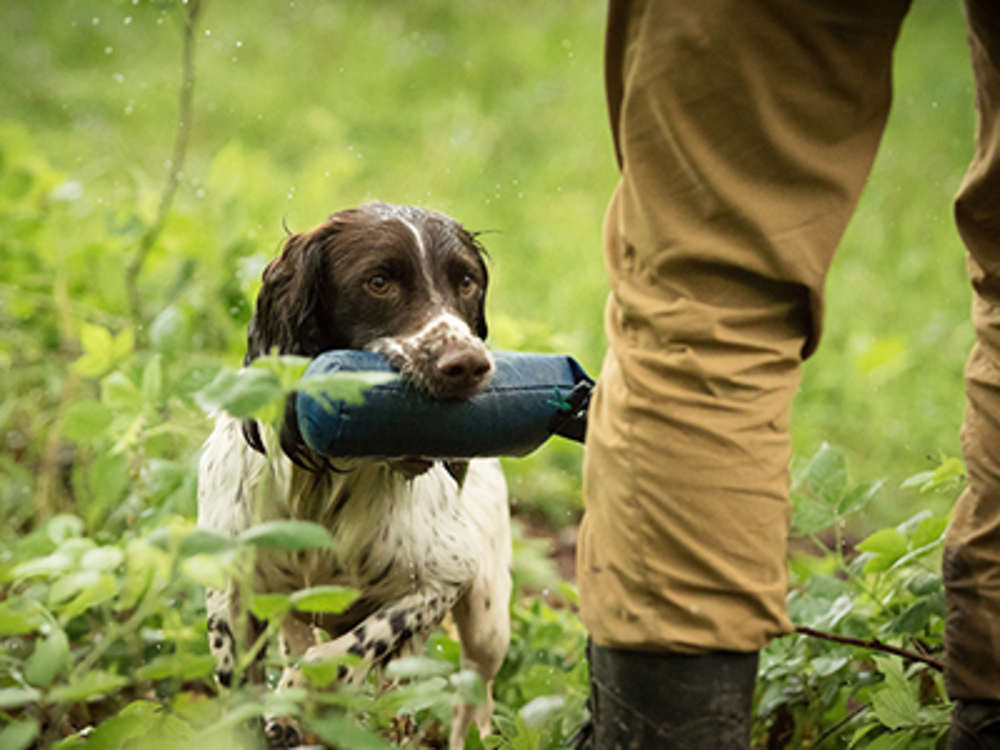
There are three levels of Kennel Club field trial judges: non panel, B panel and A panel. At your first judging appointment you will be a non-panel judge and will undertake your duties alongside panel judges.
After you have completed your first appointment you will receive your judging number from The Kennel Club. This number will stay with you throughout your judging career and must be given to secretaries when you accept an appointment for inclusion on their schedule.
Commonly searched on this page
Becoming a field trial judge
The first step to being asked to undertake your first judging appointment is to make yourself known to field trial secretaries. There are two main ways in which you can do this:
- Compete at gundog working tests and field trials; competitors who do well are often asked to judge
- Volunteer to help out at the field trials and gundog working tests held by the society
It is expected that you will be fully conversant with the Field Trial J Regulations. Before a judge can be added to a panel, they must have attended a Kennel Club Judges' Training Programme seminar on The Kennel Club J Regulations for the appropriate sub-group and have passed the examination. With effect from 1 January 2022, to remain on a judging panel, all judges must have attended a Kennel Club Judges’ Training Programme seminar on The Kennel Club J Regulations for the appropriate sub-group and must have passed the examination, unless the judge has "grandfather rights". (Please note: judges deemed to have "grandfather rights" and who are therefore exempt from Regulation J6.c.(6) are: judges who were appointed to the A panel prior to 1 January 2010, and/or were involved in the pilot scheme for the judges training programme and/or those who are, or have been a Kennel Club approved presenter.) Please read our Guide for Field Trial Judges.
First appointments
Once you have been offered your first appointment, you will need to think about your judging book. As you will have seen at trials, judges always make notes about the dogs they are assessing in a judge's book. Examples are available further down this page.
All judging appointments at field trials licensed by The Kennel Club must be underpinned by a contract between the society and the judge. Forming a contract requires three stages:
- The society must invite the judge in writing, including the wording required in the field trials regulations, and request a written acceptance
- The judge should return a written acceptance of the judging appointment
- The society should then confirm the judging appointment, again in writing
Three-part contracts should always be in place, even for emergency replacement judges. In the event of a judge or society being in breach of their contract, and unable to provide a satisfactory explanation of the breach, the board of The Kennel Club may impose a fine.
Progressing as a field trial judge
Once you have judged as a non-panel judge for a minimum of three calendar years, you can begin the application process to join the B panel. The process to be considered for the B and A panel lists is as follows:
- You must be nominated by a field trial society which is approved to hold open stakes for your sub-group and have completed at least one judging appointment for them within the three years before your application
- You will need to have passed the field trials rules and regulations examination
- The application form for the correct sub-group and relevant panel must be downloaded and completed
- To fulfil the requirements as listed below which vary slightly between the panels and sub-groups
Field trial judges evaluation forms
After a trial, it is a requirement that all panel judges complete the field trial judge evaluation form on their co-judges. B panel judges are expected to complete forms on non-panel judges and A panel judges on non-panel and B panel judges. These forms are confidential and are vitally important in the consideration of applications to the panels. The forms must be returned to the field trials department 30 days after the end of the trial.
When your nomination is received, all of the evaluation forms from your co-judges will be collated and the contents presented to the field trials committee, alongside your application, for their consideration. Once the committee has reviewed these documents their decision will be passed on to the board for final approval. After the board has met, you will be advised of the decision in writing. If your nomination is successful, your contact details will appear on The Kennel Club's official panel of field trial judges.
Note: If you are unable to complete this form online, please contact
.
Field trials newsletter
To find out more about our field trials newsletter, and how to sign up and receive them in future, please visit the newsletter section on our 'already competing in field trials' page.
Examples for laying out judging books
The field trial judges education working party has produced examples of how to lay out a judging book. There is one for each of the sub-groups.
How to lay out a Retriever judging book
The main reason for setting out your Judging book correctly is so that you have a record of each dog’s retrieves. You can also check very quickly which dogs you have had in the first round, and what dogs you require in the second round. You should also know the numbers of the dogs that have been discarded.
If the book is set out correctly all these things come to hand quickly and you should know if the dog the steward sends in the right dog. It is your job to know what dogs you require at any specific time [(Regulation J(A)3.h. applies].
Having the names of your host, Steward of the Beat and guns to hand goes a long way to a good relationship.
Starting at the front
The first double page is set out as follows:
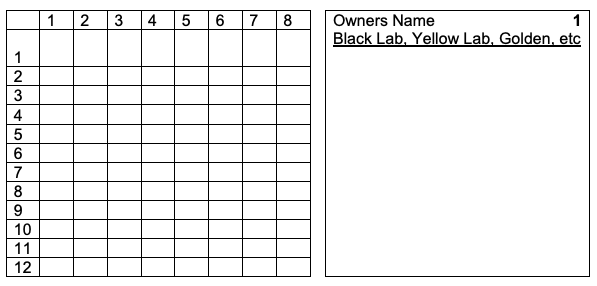
By setting the graph facing you, (opposite the first page), it is easier to put the result in and look at the rest of the pages when writing.
On the page for each dog it is better to put the name of the person handling, and what dog they have: this brings them to mind quickly. Also, if they sit at a drive make a note, then if they ask for a Drive certificate you can refer to your notes.
When a dog is put out of a trial do not tear out the page, fold it in half, back towards the centre of the book. By doing this you can always check at a later stage (if required to do so) why the dog was discarded.
Setting out at the back of the book
After the pages for each dog, you require two or three spare pages, these are for the information that keeps you straight throughout the trial. The first of the three is the most important one. The others are scrap pages you may want to use.
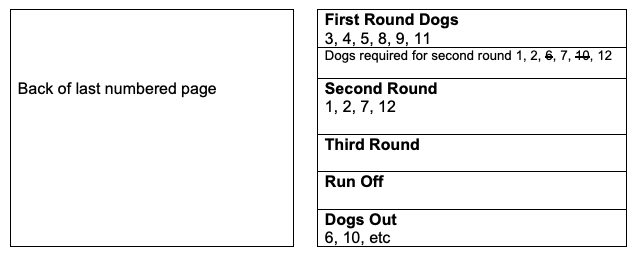
Starting at the top of the page the first box is for the dogs sent to you numerically by the dog steward in the first round.
The next box is for dogs that you have NOT seen in the first round but you know you will have to see in the second round.
As these dogs come to you circle them or put a line through them and place their number in the box below. The dogs should come to you in the order that you have put them down, and any dog not coming in the correct order must have been missed by the dog steward or put out. If you don’t know why it has not arrived, ask the dog steward.
As you see dogs put out during the trial put a cross through their number and place them in the DOGS OUT box at the bottom of the page.
At the end of the second round you should be able to see that all twelve dog numbers are in the first two boxes, all twelve dogs have been judged by you, or have been put out before they came to you.
The next two boxes are for the third round and the run off. These cannot have numbers put in until the judges have decided who they require.
You should always be able to account for every dog, at any time, during or after a field trial.
The book above is set out for the four judge system, a three judge system is not so easy. In the second round of a three judge system the main thing to watch for is that you do not get any dogs sent back to you that you saw in the first round, and that all the dogs that have come through the first round have had the opportunity of being seen in the second round.
Setting out a stewarding page - four judges
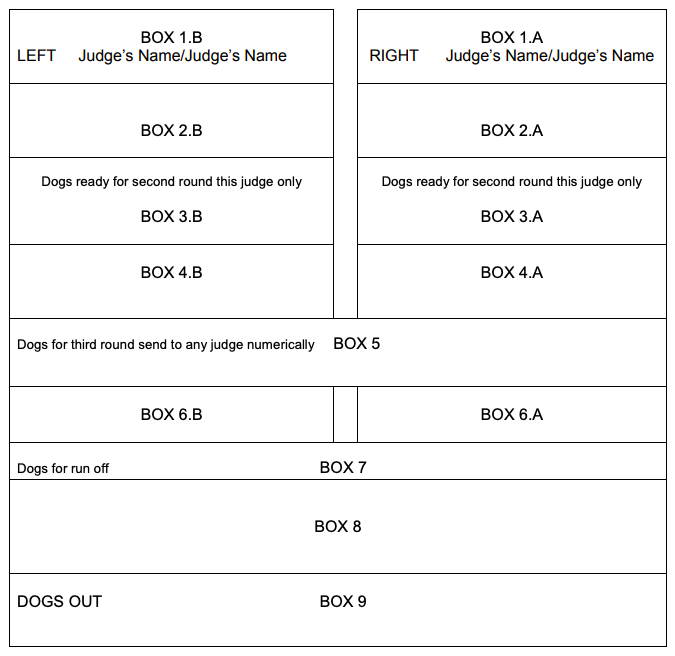
This is the stewarding page as you start in the morning. You fill in each section as you go through the day.
Each round has a section of its own. You should be able to see where and when each dog went out, and the dogs that came through.
Information for stewarding a 12 dog trial (four judge system)
| 1A and B | Fill the judges’ names in. |
| 2A and B | FIRST ROUND: Put the numbers into the boxes for each judge as you send the dogs in numerically. Number from right to left. |
| 3A and B | As each dog comes out place its number in the opposite column ready for the second round. Dogs from box 2A go to box 3B, dogs from box 2B go to box 3A. When the second round commences, when required place the dog’s number in the box below. If a dog is discarded by the first round judge, put a cross through the number and place the number in box 9. |
| 4A and B | Spaces for second round numbers. |
| 5 | After the second round the judges will give you the numbers required for the third round. Place these in Box 5 ready to send to the judges, numerically, as they require them. |
| 6A and B | Spaces for third round numbers. |
| 7 | After the third round the judges will give you the numbers required for the run off – place these in Box 7. |
| 8 | This is for the dogs in the run off. It is now up to the judges as to how many they take in – they will let you know. Place them into Box 8 as the judges require them. |
| 9 | The “dogs out” box at the bottom of the page. If a dog is put out, put a cross through its number and place the number in Box 9. |
Try to follow this trial through
This is how your page will look at the end of the day
Stewarding page at the end of the day
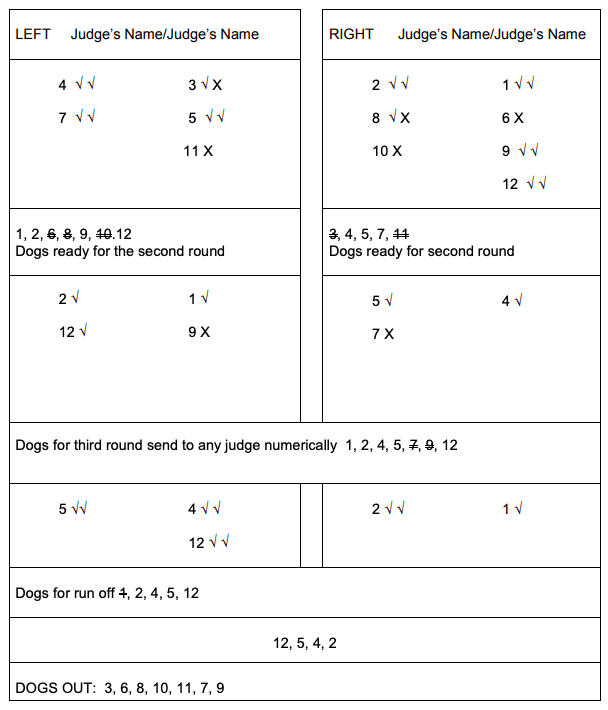
How to lay out a Spaniel judging book
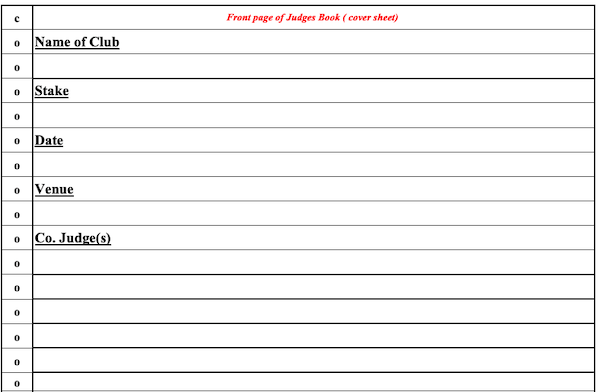
The front page of the Judges' Book could be set out as above. It is not necessary to include the headings only the information is required, i.e. name of club etc. Having this information attached to the notes taken on the day could be useful to the judge. Since the judge will presumably officiate in the future, it provides a file cover sheet which will serve as a reminder of the stake for their own later benefit, perhaps when progressing onto a judges' panel. The notes may also be required for submission to The Kennel Club in the event of any incident or dispute being reported.
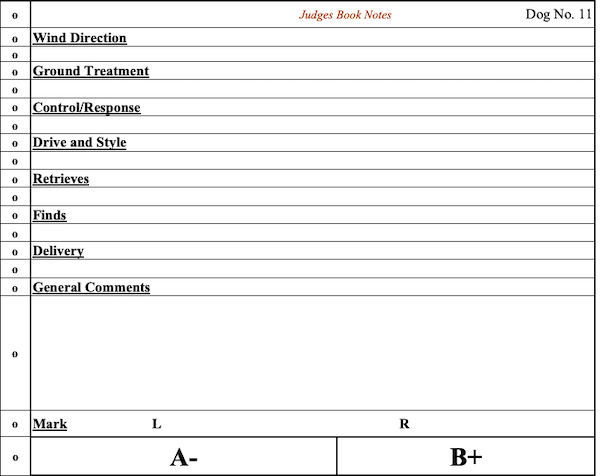
The 16 or 18 following pages of the Judges' Book could be set out as above. It is not intended that each sheet of the Judges' Book should have the above headings written on it, only the information is required. The comments are merely an indication of the conditions existing during a dog's run, together with the quality of the dog's work which the judge will have observed and may want to make a note of.
All headings are very relevant, but of special importance are the affirmations of whether or not a dog produced a flush of game and also had a retrieve at some time during the run. In this example, the right hand judge has given a B+ . Judges or their stewards may have advised each other of those dogs which have been eliminated. Both judges will then come together to compare notes and make decisions when each dog has completed its second run.
Each judge will have a grade mark on each sheet and also on the master score sheet at the back of the book. At this stage, each judge marks up the other's grade on the master score sheet, thus completing it as the discussion takes place. It can be useful to add the co-judge's grade, in this case A-, to the above sheet, since this saves leafing backwards and forwards to the master score sheet during the discussion.

How the award placings are reached
The example shown relates to both the two judge system and the four judge system. In the four judge system, each pair of judges should have discussed and agreed a mark as the stake progressed. Each judge will complete the relevant column, relating to the side of the line judged as each dog completes a run.
When all dogs retained in the stake have completed their second run, all judges will come together to compare notes and make decisions. At this stage, each judge marks up the others' grade on the master score sheet, thus completing it as the discussion takes place. When all dogs have been given an agreed grading, judges must agree the award placings and any Certificates of Merit to be conferred. These placings can on occasion be agreed by further discussion or since the example shows dogs of equal grading, if the judges after further thought cannot come to an agreed conclusion, it may be decided to hold two sets of run offs.
A separate similar sheet should be used to record the outcome of each pair of dogs, especially in more complicated situations. Dog number 1 has two A grades, therefore may be awarded 1st. Dogs 4 and 9 have the next best grading with A and A-, they may run off for 2nd and 3rd place. Number 9 competes and is regarded as the better dog, thus gaining 2nd place. Number 4 is the lesser and is given 3rd place. Similarly with numbers 5 and 14 but with a lesser grade, they compete for 4th and Certificate of Merit. Number 5 comes out best and takes 4th place. However number 13 will require deeper discussion before any recognition is granted at the judges' discretion, since Certificates of Merit are not normally given to a dog with a B+ run.
Dogs numbered 2, 7, 8, and 11 will not receive recognition. These results should then be handed to the chief steward on a separate sheet. The sheet should have 1st number 1, 2nd number 9, 3rd number 4, etc. written on it and should not have the places 1------1, 2----- 9, 3----4 since this can cause confusion.
How to lay out a Pointer and Setter judging book
Different judges have different methods of keeping the Judging Book, there is no official format, but the following notes set out a method which could be used at outset by non-panel judges and adapted by them in light of experience.
Basic advice
Always use The Kennel Club Judging Book with wet weather pages, whatever the prevailing weather conditions.
Ensure that there are sufficient wet weather pages in the book to keep a short record for each dog running in each round.
Complete the book using pencil, not biro, felt pen or other medium. This way the record will remain intact in the most extreme of conditions.
Prepare the book in outline before the day of the trial and on the day of the trial enter the details of the draw. This way the book is quickly ready for use and the Trial can commence without undue delay.
Make sure when judging that a plentiful supply of spare pencils is carried as well as a pencil sharpener. Similarly if glasses are worn by a judge they should carry a spare pair.
Setting up a Judging Book
It is as well to remind novice Judges that the Judging book is not only a record of their opinions on the dogs competing before them, but a current record of the stage and state of the trial they are judging. For this to be the case it should be completed after each brace and will be key to the way they and their fellow judge manage the trial.Prior to the day of the trial the book should be prepared for use as follows:
- The front page should be a header page with the details of the trial and the date
- The next page should have the details of the draw to be completed on the day of the trial for ready reference during the trial
- The third page should be for the draw for the second and/or third round
- The fourth page should be the ‘see again’ list for dogs the judges wish to see more of and whose run had been curtailed by the performance of their brace mate. It is advisable that this page is tabbed by a coloured marker tab for easy access and periodic reference
- The next two or three pages should be set up as follows and on which the judge’s marks will be entered after each brace to form a matrix of marks

The second and third round marks should obviously be clearly separated from the first and from each other.
Subsequent pages should be used for short notes on each dog and it is recommended that they are divided into two so that with the facing page each brace can be entered as drawn.
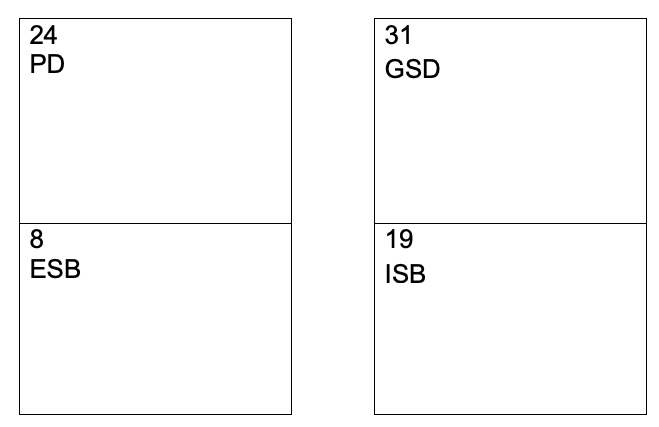
In order to keep the notes for the first, second and third rounds separate, it is advisable to have a clearly marked divider sheet at the front of each round’s notes possibly with a marker tab.
Using the Judging Book
On the day of the trial, once the draw has been completed it should be entered in the book at the front to be available for ready reference. The draw should then be entered on the pages reserved for short notes on each dog (see above). The number, breed and sex for each dog is all that is needed and for speed of purpose it is suggested that the abbreviations PD, PB, ESD, ESB, ISD, ISB, GSD, GSB, IRWSD, IRWSB be used. The entry on the left page will be the dog drawn on the left and the entry on the right facing page will be the brace mate drawn on the right.Once this has been done, the book is ready for use and at this stage some judges like to ‘call over’ their book with their fellow judge as a final check.
The trial can then commence!
- After each brace has run, the judge should confer with their co-judge and discuss the dogs that have just run, noting what has been seen by the other judge which they may have missed
- After forming an opinion on each dog, a few short notes should be made for each dog before allocating a mark and entering their number on the matrix at the front of the book
- It is important to note that at this stage the judges should aim to agree the same mark and there should be no retrospective adjustment of marks. Consistency in approach is helpful as is developing a rapport with the co-judge
- For the purposes of the system being outlined the marks to be used are A, B, C, D, & E with the addition of + or – within each category
- Once allocated, the dog’s number should be entered in the appropriate column on the matrix at the front of the Judges' Book with a + or - if necessary as further demarcation
- Even dogs that have committed an eliminating fault should have sufficient notes to enable total recall of the run if the handler enquires as to the reason for his elimination
- Similarly, dogs that have given a pedestrian performance, not hunted with style and purpose, should be given a D mark as they are deemed not up to standard
- Each judge will, over time, evolve their own shorthand for use and it is essential to be succinct when making notes, getting down the key features of a dog’s performance. Before a dog can get an award, it has to have found game and been shot over, so this needs to be noted and indicated on the matrix either by an asterisk X or S/o (Shot over)
- Provided that each brace has been entered on the matrix after they have run, and those that have been shot over marked with an X or S/o at the end of the first round, it will be possible to see at a glance who the top dogs are and which dogs might go through to the next round by looking at the A & B columns and perhaps the C column particularly for C+ marks
- At this point the judges will have a discussion to agree the dogs for the next round. If they differ, this is when the notes can be referred to as an aid to help recall of any disputed dog’s performance. Having agreed the dogs needed for the second round, the judges may run them in pairs as they see fit, otherwise there will be a draw
- Before proceeding, many judges like to count up their entries on the matrix or any lists they may use to ensure the total number of entries tallies with the number of dogs in the round and thereby ensure no dog has been omitted
- Again for a second and third round, the running order should be entered in the book in the same way as for the first round. At the end of a second round a quick reference to the matrix will indicate the top dogs for the judge. It may be that the judges at this stage feel, after discussion, that they have seen enough to make the awards. If not, a third round will be necessary and it would be usual for the judges to decide the braces and running order
- At the end of the third round, the awards, if any, should be given to the secretary for the presentation
Conclusion
A Judges' Book should be kept methodically throughout the trial without slowing the progress of the trial and be subsequently available for reference.
How to lay out a HPR judging book
Introduction
The Kennel Club's current Field Trial Regulation J(A)3.n (Judging) states:
“At the end of each retrieve or run, judges are advised to place each dog in a category such as A or B (+ or -) according to the work done. Such gradings may, quite properly, be supplemented on occasion by additional notation for reference purposes when judges are going through their books. It is, however, imperative to appreciate that gradings must never be retrospectively adjusted. Neither should there ever be any attempt to sum sequences of grades to produce a single letter grading of a dog. When all dogs have been seen by a judge, or judges, they will wish to confer to determine which dogs they wish to discard or retain; it is vitally important for judges to make short notes of each dog’s work. Judges should never expect to be able to trust to memory.”
The system formerly used for marking HPR trials was in conflict with this regulation since it called for judges to give marks out of 10 on a score sheet for four categories of work, hunting, gamefinding, pointing and retrieving, to be averaged at the end of the day. The gamefinding marks were averaged and multiplied by two, and marks out of 5 for style and water were added.
This system was complicated and even though the marks on the score sheet could be corroborated by notes made for each round, at the end of a long eventful day they could be misleading. For instance, a judge may not have felt he could award a very high mark to a dog which completed a retrieve absolutely perfectly because the retrieve was very easy; a dog which hunted enthusiastically and thoroughly may be given a low mark because it produced no game from a beat which appeared to be promising; a dog with very high marks for retrieving could end up placed higher than one which had been consistently very good in all aspects of HPR work.
It was felt that HPRs should adopt a more simple system, as outlined in Regulation J(A)3.n, whereby a single grading is given for each round which will reflect the overall performance in that round. Each grading will be supported by written notes on a separate page for each dog, which will detail how that dog performed the different aspects of HPR work it was able to exhibit. The grading will be entered on a chart similar to the score sheet which will form the centre of the Judges’ Book. This chart will also have boxes for each dog which can be ticked when the dog has achieved a point, a retrieve and been shot over, and there will be two boxes after the third round, one for a water test grading and one labelled ‘awards’. The chart will thereby enable judges to see at a glance which aspects of its work a dog needs to fulfil in later rounds to complete the ‘basic requirements’. Even if a dog does not have the opportunity to point or retrieve in a particular run, its attitude to its work, its treatment of the ground allotted to it and its behaviour will allow the judges to make an assessment and grade it accordingly for those aspects it has fulfilled. Judges may like to tick the retrieving and pointing boxes each time a dog has a point or a retrieve. They could also mark the retrieving box with a question mark to remind them if a dog is suspected of hard mouth.
The Kennel Club Regulation suggests using letter gradings and the letters ‘A’ to ‘C’ can be used to cover runs where dogs have not committed an eliminating fault, whilst ‘D’ can mean discarded and ‘E’ eliminated. The ‘A’ to ‘C’ gradings can be augmented by + or – thus giving scope for more distinction between the work of different dogs.
Marking the Judges’ Book
Judges must have in their minds the category of the stake and the good standard of work required of a dog if it is to be worthy of progression to the next round and be in line for an award, and the dog must achieve this standard in all aspects of HPR work. Such work should be graded ‘A’ (+ or -). A grading of ‘B’ should be given if a dog has run for the most part to a good standard but may have fallen slightly below this standard in perhaps one aspect of HPR work. After consultation the judges may agree to run the dog again and at the end of the day may include it in their awards. A grading of ‘C’ should be given for below standard performances which will have exhibited major faults.
After each dog’s run, the judges should confer with each other and discuss its work noting anything that has been seen by one judge and not another. Having formed an opinion on the dog they should make notes on the page provided adding a grading and then enter that grading on the chart for that particular run. The judges should aim to agree on a grading at this stage and there should be no retrospective adjustment of marks. Consistency in their approach is important as is developing a rapport with their co-judge.
At the end of the first round the judges will need to decide which dogs they wish to see again in the second round and will be able to determine at a glance, those which, from the grading given and their notes, have performed to a high enough standard to deserve a second run. During the second round if there are spare retrieves available, judges may bring back dogs out of draw order to make these retrieves. These spare retrieves do not count as a ‘run’ but are supplemental to a run in which a dog may not have had a retrieve, or where judges wish to see a dog or dogs make additional retrieves and, of course, they should be assessed and noted.
At the end of the second round, judges will again have to decide which dogs they would like to see in a third round. It will not be necessary to see again dogs which have had the opportunity to exhibit all the ‘basic requirements’ within the first two runs. There may well be dogs which have worked to a good standard and achieved high gradings but have still not had the opportunity to either point and/or retrieve. The ‘tick’ boxes for pointing and retrieving will confirm this at a glance. These dogs can be given a further chance to complete the basic requirements. There may also be dogs which need to be tested again for retrieving in order to confirm that they are not hard mouthed, or for some other aspect of HPR work which the judges have not been able to assess sufficiently.
After the third round, the judges will need to confer with each other and, using the notes and the gradings they have allocated, will be able to see which dogs have pleased them most and are in line for an award, subject to completion of the water test. It is very seldom in HPR trials that two or more dogs are exactly equal in the quality of their performances but if, after comparison of their notes and discussion the judges fail to agree on the order of possible awards, they may wish to run certain dogs again in a run off to determine this.
To receive an award, HPRs also have to successfully complete a water retrieve. This test can be conducted at any time during the course of the trial but usually takes place at the end after the judges have decided which dogs are in line for an award. The dogs should be graded in the same way as for the previous rounds in accordance with the standard required for receiving an award.
Following the completion of the water test, the judges will be able to come to a final decision as to which dogs shall receive awards and Certificates of Merit and in what order.
A summary of how work should be graded is as follows:
| Grade ‘A’ + or - | The dog has worked to a standard worthy of an award. |
| Grade ‘B’ + or - | The dog has worked a little below award winning standard. An award may be considered if other runs have been up to ‘A’ standard. |
| Grade ‘C’ | The standard of work is below an award winning standard and the dog may have committed major faults. |
| Grade ‘D’ | The standard of work is well below award winning standard; the dog has committed major faults and will be discarded. |
| Grade ‘E’ | The dog has committed an eliminating fault and is, therefore, eliminated. |
The following illustrates the chart which will form the centre pages of the Judges' Book with some examples of grades given. This can be printed on an A5 sheet (half A4) and folded. A further four folded A5 sheets will be required to form the note pages for each dog, the front page and some spare pages for other notes such as the names of the steward of the beat, the guns and the chief steward.
This chart can also easily be used by the chief steward to keep abreast of which dogs will be required next in line and for noting which dogs the judges will require for a third run or for the water test. They will also be able to finally make a note of the awards the judges wish to make.
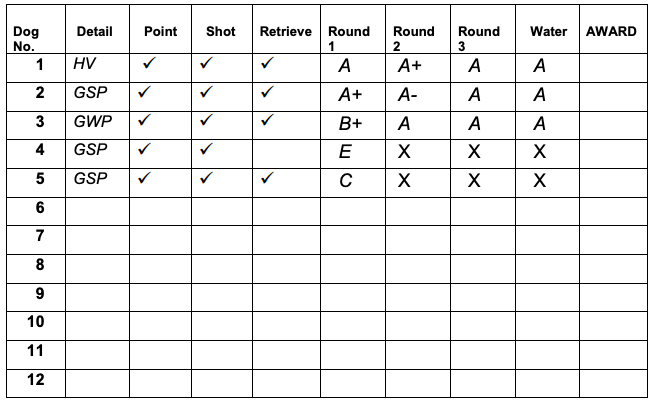
Requirements for each panel and sub-group
The requirements required for each sub group and panel are below.
Retrievers and Spaniels
B panel
- You must have handled a dog to win at least one field trial stake for your sub-group and have considerable field trial experience
- You must have judged at trials held by at least two different societies
- You must have judged over a minimum period of 36 months, and a maximum period of 60 months
- Retrievers - You must have judged a minimum of six stakes with at least five different A panel judges
- Spaniels - You must have judged a minimum of six stakes with at least 5 different A Panel judges. Of these, you must have judged a minimum of two stakes under a two judge system and two stakes under a four judge system.
A panel
- You must have handled a dog to win at least one open stake or in the case of Retrievers, been placed 2nd in a 2-day open stake and, since being added to the B panel, have substantially increased your field trial experience
- You must have judged at trials held by at least two different societies
- You must have judged a minimum of six stakes, of which three must be open, with at least five different A panel judges at trials over a minimum period of 36 months, and a maximum period of 60 months
Pointers and Setters
B panel
- You must have judged at trials held by at least two different societies
- You must have judged a minimum of four trials over a minimum period of 36 months, and a maximum period of 60 months
- You should have experience of judging both partridge/pheasant and grouse trials
-
You must of judged a minimum of four trials with at least four different A Panel judges.
A panel
- You must have judged at trials held by at least two different societies
- You must have judged a minimum of four trials, of which at least two must be open, with at least four different A panel judges at trials over a minimum period of 36 months, and a maximum period of 60 months
- You should have experience of judging both partridge/pheasant and grouse trials
-
You must of judged a minimum of four trials of which at least two must have been open stakes, with at least four different A Panel judges.
HPRs
B panel
- You must have judged at trials held by at least two different societies
-
You must have judged a minimum of six stakes with at least five different judges over a minimum period of 36 months, and a maximum period of 60 months
A panel
- You must have judged at trials held by at least two different societies
-
You must have judged a minimum of eight stakes, of which at least three must have been open stakes, with at least five different A panel judges at trials over a minimum period of 36 months, and a maximum period of 60 months
Judges' education programme
This programme has been created to manage the understanding of the J Regulations for field trial judges, societies and competitors. This is done through seminars for each of the four sub-groups followed by a multiple choice exam. Before a judge can be added to a panel, they must have attended a Kennel Club Judges' Training Programme seminar on The Kennel Club J Regulations for the appropriate sub-group and have passed the examination. With effect from 2 February 2023, to remain on a judging panel, all judges must have attended a Kennel Club Judges’ Training Programme seminar on The Kennel Club J Regulations for the appropriate sub-group and must have passed the examination, unless the judge has "grandfather rights". (Please note: judges deemed to have "grandfather rights" and who are therefore exempt from Regulation J6.c.(6) are: judges who were appointed to the A panel prior to 1 January 2010, and/or were involved in the pilot scheme for the judges training programme and/or those who are, or have been a Kennel Club approved presenter.)
Societies, individuals or groups organising a seminar should contact one of the approved presenters to invite them to conduct the seminar and arrange a suitable venue.
Upcoming J regulations seminars
Details of upcoming regulations and judging procedure seminars can be found in the seminar diary, or you can contact an approved presenter for further information.
Seminar scripts for Kennel Club J regulations
The following Guides are used as a Seminar Script to provide the basis upon which the Approved Presenters make their presentation at a J Regulation Seminar:
The field trials approved presenters have produced examples of exam questions for each of the sub-groups.
Spaniel example exam questions
1. On a four judge system a pair of judges should:
a) give two separate marks for each dog
b) give an average mark between the pair of judges
c) agree a suitable mark based on the dogs performance
d) ask the judges’ steward what they think
Answer: c (Ref: J(A)3.n)
2. In the first round, your next dog required in line is a handler running two dogs and they are currently running under the other judge(s), do you:
a) hold your side of the line until the dog and handler is available
b) call in any dog and handler in any order
c) ask the chief steward what dog they should run
d) move on to the next available number dog and handler and then bring in the passed over dog as soon as possible
Answer: d (Ref: J(C)3)
3. Which of these is an eliminating fault?
a) quiet handling
b) hard mouth
c) not stopping to flush
d) disturbing ground
Answer: b (Ref: J(C)5)
Pointer and Setter example exam questions
1. The chief steward at a trial is responsible for:
a) helping judges makes decisions
b) deciding in which direction the trial shall proceed
c) deciding which dogs should be called into line
d) ensuring that the regulations are observed
Answer: d (Ref J9.a.(1))
2. Which regulation in The Kennel Club Year Book covers Pointer and Setter field trials?
a) J(B)
b) J(C)
c) J(D)
d) J(E)
Answer: c (Ref J(C))
3. After a trial, a judge should:
a) be prepared to show their book to competitors
b) be prepared to explain how the result was achieved
c) refuse to answer questions
d) be prepared to discuss the work of individual competitors on a one to one basis without debate
Answer: d (Ref J)
Retriever example exam questions
1. A handler comes into line with another person who is introduced as the owner who wishes to watch their dog more closely. Do you:
a) tactfully explain that only competing dogs and handlers can be in line and ask the owner to return to the spectators
b) ask them to speak to the chief steward and provide details
c) tell them where they should stand in line, in reasonably close proximity, and explain to them that they cannot play any part in the handling of the dog
d) let them come into line but put them with a steward well away from their dog, so that they cannot interfere with the handling
Answer: c (Ref: J.9b.(7))
2. One of the appointed judges becomes ill on the morning of the trial and the chief steward asks you to judge in their place. You are the only qualified judge who is available. You see in the card that there is a dog running that you sold eight months previously. Do you:
a) refuse to judge because there is a dog running you had owned
b) ask the handler of the dog to withdraw it
c) agree to judge, having pointed out to the chief steward that you had previously owned one of the dogs in the stake
d) tell the chief steward that the trial must be cancelled
Answer: c (Ref: J.13a.(5))
3. In a 16-dog stake there are two dogs left in the first round needing retrieves, in a four judge system. Dog 14 is on the right and dog 16 is on the left. What should the judges do?
a) Take 14 to back up 16 before bringing in second round dogs
b) Bring in second round dogs, one to each side, in correct order
c) Take 14 and 16 to the centre of the line so that they can retrieve game shot by any of the guns
d) Give 15 an opportunity to be tried against 13
Answer: b (Ref: J(B)7.d.(3))
HPR example seminar exam questions
1. A handler arrives at a field trial and asks to be allowed to run his own two dogs and also a dog belonging to a friend who he says is ill and cannot compete. Can he be permitted to do so?
a) Yes, because one dog will be under separate ownership
b) No, because except in the championships, a handler may handle no more than two dogs
c) Yes, if there are insufficient dogs to make up the maximum allowed for the stake
d) No, because the name of the handler cannot be changed once the card is printed
Answer: b (Ref: J9.b.(6))
2. In an open stake a dog, running into wind, fails to point a bird but stops to flush. The judges should:
a) Credit it for being steady to flush and run the dog on
b) Mark the dog down if scenting conditions appear unfavourable
c) Eliminate the dog
d) Give the dog another run in the next round
Answer: c (Ref: J(E) 6)
3. To gain a Water Certificate towards the title of Field Trial Champion, an HPR is required to:
a) Enter water and retrieve a dummy to hand
b) Enter water and swim to the satisfaction of two panel judges, one of whom must be on the A Panel.
c) Enter water and retrieve a bird from across a river.
d) Enter water and swim at least 30 yards.
Answer: b (Ref: J(A)2 & K(7)
Additional resources
There are a number of resources which you can purchase to help assist you with your judging.
Our online shop has all the publications you need:
Please explore these useful free resources:
